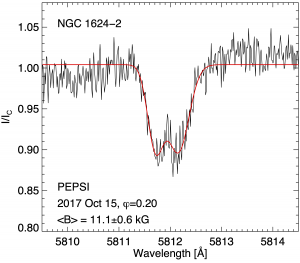NGC 1624-2 is an O7f?p star with a reported probable polar magnetic field strength ≥20 kG, which is the strongest magnetic field ever measured in an O-type star. We study the variability of the mean longitudinal magnetic field <Bz> and the mean field modulus to obtain constraints on its field geometry. Only one magnetic pole is observable over the rotation cycle. The approximately sinusoidal variation of <Bz> and the ratio of the values of the extrema of indicate that there is an important component of the field that is dipolar. The <Bz> values measured over the rotation cycle are in the range from -0.2 to 4.5 kG, whereas the values for vary between 9 and 12 kG. The <Bz> values obtained using the O III λ7455 emission line are in the range from 0.4 to 2.3 kG and show a variability pattern similar to that detected for the absorption lines. The fact that the phase of the <Bz> minimum coincides with the phase of the maximum, indicates that the field structure must significantly depart from a centred dipole. Further, we discuss the nature of the observed variable Stokes V profiles corresponding to a longitudinal field of negative polarity detected in the emission He I lines and present the first magnetohydrodynamical numerical simulations of the gas flow in the magnetosphere of this star.

Read more: Järvinen et al., 2021, MNRAS, 501, 4534, in arXiv
